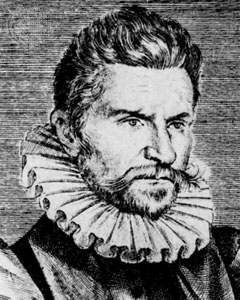posted by Lucy Rayfield
When thinking about the Renaissance, one of the first figures to
come to mind is Shakespeare. Most of us can name several of his
plays and even quote a few of his most famous lines: ‘Wherefore art
thou Romeo’, ’To be or not to be’, ’Now is the winter of our
discontent’. Sound familiar? Well, how about Robert Garnier? Jean
de la Taille? Étienne Jodelle?

Probably not. People are often surprised to learn that France also
had its Shakespeares. This is not to say, however, that French
playwrights were unimportant. Théodore de Bèze was one of the
first European authors to use theatre as a vehicle for political and
religious propaganda, with his polemical tragedy Abraham sacrifiant
(c. 1550). Figures such as Jean-Antoine de Baïf worked tirelessly to
popularise Plautine and Terentian drama in the early modern period,
producing and circulating modern translations of classical plays.
Pierre de Larivey wrote a sellout collection of comedies in 1579,
which continued to be reprinted throughout the century, and
Parisian dramatist Alexandre Hardy (c. 1569-1631), is said to have
written around six hundred plays.
Farce was a well-known genre in France even before the dawn of
the Renaissance. Le Garcon et l’Aveugle, telling the tale of a young
boy who tricks his master out of a large sum of money, was written
in the thirteenth century, at least a hundred years before the first
farce appeared in Britain. The anonymous Farce de maître Pierre
Pathelin (c. 1457), recounting the fate of a cunning lawyer, was then
the first European farce to generate widespread interest: it was
translated into several languages and published all across France
for well over two centuries. French playwrights also produced many
acclaimed mystères (portraying scenes from the Bible), moralités
(depicting a fight between good and evil), and was also renowned
for its sermon joyeux: a parody of the sermon from a Catholic mass,
narrated by a comic actor.
![A 1465 woodcut of 'La Farce de maître Pierre Pathelin' [Picture 3]](http://bookshelf.mml.ox.ac.uk/wp-uploads/2015/11/A-1465-woodcut-of-La-Farce-de-maître-Pierre-Pathelin-Picture-3.jpg)
With the arrival in the French court of eminent Italian figures such
as Catherine de’ Medici and Ippolito d’Este, France was exposed to
neoclassical drama, which had started to be produced by Italian
humanists during the last years of the fifteenth century. This was to
be a turning point in French theatre. In 1554, the queen Catherine
de’ Medici commissioned a translation of Giangiorgio Trissino’s La
Sofonisba, which was to be the first humanist tragedy to appear in
the French language. The play encountered great success and
many French playwrights endeavoured to retranslate or to imitate it.
Catherine also sponsored the first neoclassical comedy (known as
commedia erudita) to appear in France: the Cardinal Bibbiena’s La
Calandra. This was the first time that France had seen a comedy
with a real stage, musical interludes, lavish costumes and a
professional acting troupe: it was enjoyed by thousands of
bewitched spectators and set an entirely new standard for theatre.
In fact, Catherine enjoyed the performance so much that in later
productions she often joined in the acting herself!
![Catherine de' Medici playing the role of 'Columbine', possibly with the Ganassa troupe (c. 1574) [Picture 4]](http://bookshelf.mml.ox.ac.uk/wp-uploads/2015/11/Catherine-de-Medici-playing-the-role-of-Columbine-possibly-with-the-Ganassa-troupe-c.-1574-Picture-4.jpg)
Later French monarchs were eager to enrich this new theatrical
tradition. King Henri II ordered the dramatist Jacques Grévin to
write La Trésorière, a widely successful comedy based on the
Italian style, and Henri’s successor, King Charles IX, was a great
supporter of the many Italian acting troupes who sought work in
France. Marguerite de Navarre, princess of France, also helped
introduce the writings of Matteo Bandello into the rest of Europe.
Bandello was to compose a novella elaborating a tragic love-story
between two young Italians, Romeo and Giulietta. Any guesses as
to what this later inspired?
![The title-page of the first edition of Shakespeare's 'Romeo and Juliet' (1597) [Picture 5]](http://bookshelf.mml.ox.ac.uk/wp-uploads/2015/11/The-title-page-of-the-first-edition-of-Shakespeares-Romeo-and-Juliet-1597-Picture-5.jpg) In short, it is a shame to gloss over this rich theatrical past, which
In short, it is a shame to gloss over this rich theatrical past, which
formed an innovative and exciting part of sixteenth-century French
literature. If you have any questions, please get in touch with me at
lucy.rayfield@mod-langs.ox.ac.uk. I am always pleased to talk
about Renaissance drama!

!['Les Comedies Facecieuses', by Larivey [Picture 2]](http://bookshelf.mml.ox.ac.uk/wp-uploads/2015/11/Les-Comedies-Facecieuses-by-Larivey-Picture-2.jpg)
I’m currently an IB student and as part of my final exam i’m going to be presenting about French Farce. I’d love it if you help me out by answering some questions please.
1) How are the upper and lower class differentiated through movement within French farce?
2) What are some of the most important conventions and characteristics of french farce?